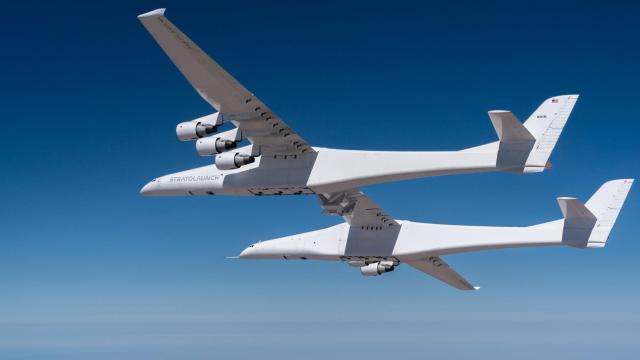The biggest aeroplane ever built just flew over the Mojave desert for its fifth test flight, inching closer to fulfilling its role of carrying and releasing hypersonic vehicles.
Private aerospace company Stratolaunch tested the carrier aircraft on Wednesday and is currently analysing the data gathered during the test flight, according to a company press release. It’s the fifth flight of the gigantic vehicle since tests started three years ago.
Roc, named after the giant bird in ancient Middle Eastern mythology, flew for a total of 4 hours and 58 minutes, reaching an altitude of 6,858 metres. For this flight, the team behind the aeroplane tested out a new pylon on the plane’s centre wing that’s designed to carry hypersonic vehicles into the air (hypersonic refers to vehicles or missiles capable of travelling faster than Mach 5). The pylon, which measures 4.3 metres in length, should eventually carry the company’s reusable hypersonic test aircraft, known as Talon-A.
Stratolaunch was founded by Microsoft co-founder Paul Allen, who died a year before Roc took off for the first time in 2019. When Stratolaunch was first established, the company’s initial goal was to fly the very large plane to a high altitude from where it would launch the Orbital ATK’s Pegasus XL rocket into space (similar to how Virgin Galactic’s SpaceShipTwo currently works). Following Allen’s death, however, Stratolaunch switched its focus to developing, deploying, and flying hypersonic vehicles instead, setting low Earth orbit aside.
Last year, the company resurrected its rocket-powered hypersonic vehicle concept, which was part of Allen’s original vision for the company. Stratolaunch announced that it was planning to develop a larger hypersonic vehicle, dubbed Talon-Z, and a spaceplane nicknamed Black Ice that would carry payloads — and possibly passengers — to Earth orbit.
In December, Stratolaunch announced a contract with the Pentagon’s Missile Defence Agency to provide a testbed for developing defence strategies against hypersonic threats. Stratolaunch is seeking to mimic these missile threats with its hypersonic vehicles.
The U.S. government, worried about missile threats from China and Russia, has sought to amp its hypersonic weapons system and step-up its defence game. As hypersonic vehicles travel at high speeds, they are hard to detect, making it difficult for defenders to issue warnings prior to an attack. The latest test with Roc marks an important step forward for Stratolaunch and its partners.
“Today’s successful flight validates important hardware improvements to the carrier aircraft,” Zachary Krevor, Stratolaunch chief executive officer and president, said in a statement. “The pylon is a crucial component of our combined launch system, and I am proud of the team’s timely and quality integration work that occurred since our last test flight.” Stratolaunch is hoping to begin testing the Talon-A hypersonic vehicles later this year, according to Krevor.
The force is strong in this plane. Roc has successfully landed back at Mojave Air and Space Port and our team is already busy analyzing the data gathered today. #Maythe4thBeWithYou #LetsRoc pic.twitter.com/XK7jz6SEET
— Stratolaunch (@Stratolaunch) May 4, 2022
The carrier aircraft weighs about 250 tons and boasts a wingspan that stretches 117 metres across. To me, Roc gives the impression of two planes huddled together in synchronised flight. The machine packs six 747 jet engines, rolls on 26 wheels, and can carry up to 125 tons of fuel. To gear itself up for take off, the plane needs to move through 3,657.60 m on the runway. Stratolaunch expects to begin tests of its hypersonic vehicles in 2023.
